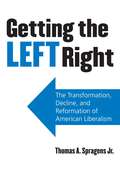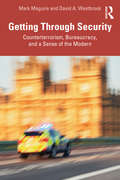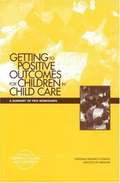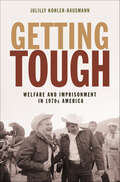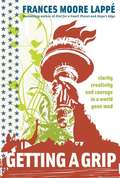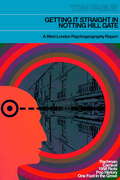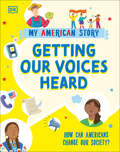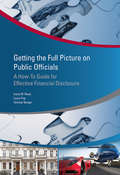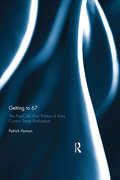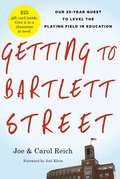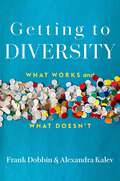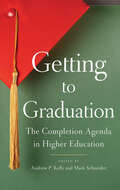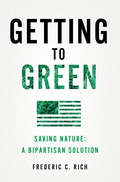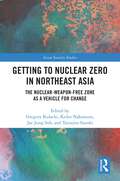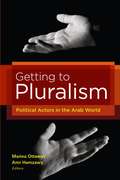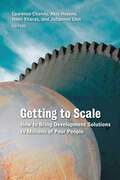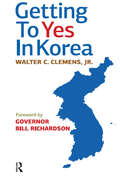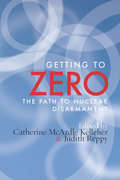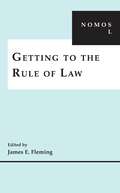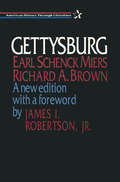- Table View
- List View
Getting The Left Right: The Transformation, Decline, And Reformation Of American Liberalism
by Thomas A. Spragens Jr.American liberalism has much to be proud of. It is largely responsible for the democratization of political power during the nineteenth century and the harnessing of buccaneer capitalism, for the New Deal's social safety nets and the civil rights legislation of the 1960s. But as the social agenda--and perceived snobbery--of postsixties liberalism alienated the working classes whose interests liberalism had previously championed, "liberal" soon became a dirty word on the political landscape. Noted scholar Thomas Spragens seeks to uncover the animating purposes, changes, problems, and prospects of liberalism as it is understood in today's political discourse. For if liberalism is to regain its rightful standing, he argues, it needs to recover its populist heart-to recommit itself to the ideal of government of, by, and for the people envisioned by Lincoln. Blending political theory with astute analysis of the contemporary scene, Spragens steps back from the "high liberalism" of John Rawls, Ronald Dworkin, and others, arguing instead that the success of liberalism hinges upon its recognition of the limits of social justice and its rededication to the core values of popular self-rule and universal self-realization--especially the capacity of ordinary citizens for personal development through education, occupation, and the practice of politics itself. Spragens first offers a detailed account of the contrast between the older and more recent versions of liberal public philosophy and considers the causes of these political philosophical transformations. He then examines the problematic aspects of contemporary liberalism and provides suggestions for a reoriented social agenda that is more compelling morally and more appealing politically. He concludes by addressing liberals' legitimate concerns about advancing social equality, their worries about imposing values in a pluralistic society, and their fears regarding the possible dangers of self-rule. Forcefully argued and well grounded within recent debates in political philosophy, Getting the Left Right compellingly argues that if twenty-first century liberalism defines its main mission as the egalitarian reallocation of social resources, it will doom itself to political futility and defeat. But if it instead champions the achievement of a society in which all democratic citizens can govern themselves and lead fulfilling lives, it can write a bright new chapter in its illustrious career.
Getting Through Security: Counterterrorism, Bureaucracy, and a Sense of the Modern
by David A. Westbrook Mark MaguireGetting Through Security offers an unprecedented look behind the scenes of global security structures. The authors unveil the “secret colleges” of counterterrorism, a world haunted by the knowledge that intelligence will fail, and Leviathan will not arrive quickly enough to save everyone. Based on extensive interviews with both special forces and other security operators who seek to protect the public, and survivors of terrorist attacks, Getting Through Security ranges from targeted European airports to African malls and hotels to explore counterterrorism today. Maguire and Westbrook reflect on what these practices mean for the bureaucratic state and its violence, and offer suggestions for the perennial challenge to secure not just modern life, but humane politics. Mark Maguire has long had extraordinary access to a series of counterterrorism programs. He trained with covert behavior detection units and attended secret meetings of international special forces. He found that security professionals, for all the force at their command, are haunted by ultimately intractable problems. Intelligence is inadequate, killers unexpectedly announce themselves, combat teams don’t arrive quickly enough, and for a time an amorphous public is on its own. Such problems both challenge and occasion the institutions of contemporary order. David Westbrook accompanied Maguire, pushing for reflection on what the dangerous enterprise of securing modern life means for key concepts such as bureaucracy, violence, and the state. Introducing us to the “secret colleges” of soldiers and police, where security is produced as an infinite horizon of possibility, and where tactics shape politics covertly, the authors relate moments of experimentation by police trying to secure critical infrastructure and conversations with special forces operators in Nairobi bars, a world of shifting architecture, technical responses, and the ever-present threat of violence. Secrecy is poison. Government agencies compete in the dark. The uninformed public is infantilized. Getting Through Security exposes deep flaws in the foundations of bureaucratic modernity, and suggests possibilities that may yet ameliorate our situation.
Getting To Positive Outcomes For Children In Child Care: A Summary Of Two Workshops
by Board On Children Families YouthA summary on Getting To Positive Outcomes For Children In Child Care
Getting Tough: Welfare and Imprisonment in 1970s America (Politics and Society in Modern America)
by Julilly Kohler-HausmannThe politics and policies that led to America's expansion of the penal system and reduction of welfare programsIn 1970s America, politicians began "getting tough" on drugs, crime, and welfare. These campaigns helped expand the nation's penal system, discredit welfare programs, and cast blame for the era's social upheaval on racialized deviants that the state was not accountable to serve or represent. Getting Tough sheds light on how this unprecedented growth of the penal system and the evisceration of the nation's welfare programs developed hand in hand. Julilly Kohler-Hausmann shows that these historical events were animated by struggles over how to interpret and respond to the inequality and disorder that crested during this period.When social movements and the slowing economy destabilized the U.S. welfare state, politicians reacted by repudiating the commitment to individual rehabilitation that had governed penal and social programs for decades. In its place, they championed strategies of punishment, surveillance, and containment. The architects of these tough strategies insisted they were necessary, given the failure of liberal social programs and the supposed pathological culture within poor African American and Latino communities. Kohler-Hausmann rejects this explanation and describes how the spectacle of enacting punitive policies convinced many Americans that social investment was counterproductive and the "underclass" could be managed only through coercion and force.Getting Tough illuminates this narrative through three legislative cases: New York's adoption of the 1973 Rockefeller drug laws, Illinois's and California's attempts to reform welfare through criminalization and work mandates, and California's passing of a 1976 sentencing law that abandoned rehabilitation as an aim of incarceration. Spanning diverse institutions and weaving together the perspectives of opponents, supporters, and targets of punitive policies, Getting Tough offers new interpretations of dramatic transformations in the modern American state.
Getting a Grip: Clarity, Creativity, and Courage in a World Gone Mad
by Frances Moore LappeThe author breaks the conventions by interweaving fresh insights, startling facts, and stirring vignette of ordinary people pursuing creative solutions to the most pressing global problems.
Getting it Straight in Notting Hill Gate: A West London Psychogeography Report
by Tom VagueFrom 43AD, and the building of the (no doubt very straight) Roman Great West Road to Silchester, to 2009, another bout of Carnival Riots and David Cameron getting his bike nicked outside Tescos on the Grove, (retrieved with the help of a friendly / non-class conscious Rasta), long time Portobello Road resident and local historian/psychogeographer Tom Vague takes us on a breathless romp through the peoples history of W10, taking in Roman Coffins on Ladbroke Grove and Civil War skirmishes in Holland Park, Russian occultists at 77 Elgin Crescent, Tory anarchist GK Chesterton and his Napoleon of Notting Hill, Thomas Hardy compering poetry nights at 84 Holland Park Avenue with Wyndham Lewis and Ezra Pound, the pre WW1 Vorticist art HQ on Campden Hill Road ,WW2 bombs on Ladbroke Grove, Halliday Christie moving to 10 Rillington Place, teenage teddy boys rampaging at the Prince of Wales Cinema on Harrow Road, Max Mosely painting fascist Union Movement graffiti around Notting Hill in 1956, Peter Rachman renting properties to the 'blacks and Irish' before ruthlessly exploiting them all and ratcheting up local tensions, the infamous race riots of 1959, future Home Secretary Alan Johnsons' original mod band the Area playing the Pavillion pub on North Pole Road in 1965, Pink Floyd at the Free School, All Saints Church, 1966, Performance, Powis Square 1969, Mick Farrens' proto-punk Deviants at 56 Chesterton Road in 1970, Strummer, Jones and Simenon's Clash on the Westway, in the Elgin, at the carnival riots....
Getting our Voices Heard: How can Americans change our Society? (My American Story)
by DKInspires young learners to explore America&’s government institutions through the nation&’s history and the experience of modern AmericansPart of an inspiring series of books that will support students to understand government and civics in modern America through the historical events and people that have shaped them, Power for the People will interweave historical context, events, and personalities with the experiences of modern Americans to help students understand key social studies topics including the origins of American institutions and values and their relevance to young people&’s lives today.The book explores the institutions and systems of American government as a constitutional republic, and the reasons for them, including roles of President, Congress, Supreme Court, state government and other national and international bodies. Historical topics / events covered include: US Constitution and amendments, elections, and key historical Presidents.
Getting the Full Picture on Public Officials: A How-to Guide for Effective Financial Disclosure
by Ivana Maria Rossi Laura Pop Tammar BergerFinancial disclosure systems are a vital component of transparency. By now 161 countries around the world have introduced financial disclosure systems, becoming commonplace around the world. But, although the rules are on the books, many practitioners are still struggling with the intricacies of the rules and how to implement them in the socioeconomic, historical, and legal context of their own country. Little guidance is available to assist them. This book aims to fill that void and provide practitioners with practical scenarios to consider before deciding on a particular course of action. This book contains short chapters that elaborate each topic and provide clear guidance on the issues that policy makers and those involved in the implementation of financial disclosure obligations will need to take into account before making a decision. How do you decide who should file? And how often? On-line or in hard copy? And what exactly? Everything they own directly—or also those apartments they own indirectly? How should information in declarations be checked? Should it be shared with public? How accessible should it be? This is the sort of practical guidance that this book aims to provide.
Getting to 67: The Post-Cold War Politics of Arms Control Treaty Ratification
by Patrick HomanAll four post-Cold War presidents have attempted to negotiate and ratify at least one major arms control agreement. However, their experiences with arms control treaty ratification have differed greatly from those of their Cold War predecessors. The main theme of this book is that domestic politics have significantly impacted attempts to ratify arms control treaties in the polarized post-Cold War political environment. Each president and each treaty faced varying amounts of support and opposition from the numerous institutions and agents within American foreign policy-making. This book uses an eight-point analytical framework to examine five post-Cold War arms control treaty ratification debates in order to try and determine what political conditions or variables account for their success or failure.
Getting to Bartlett Street
by Joel Klein Carol Reich Joe ReichGetting to Bartlett Street is the inspiring story of Joe and Carol Reich--heroes in the education reform movement--how they built a school, changed the lives of many children, and helped redefine the system in the process. Joe and Carol Reich have spent the past three decades and a personal fortune to help underprivileged children access the same kind of high quality education that wealthier Americans enjoy. Yet few people even know who they are. In Getting to Bartlett Street, for the first time, Joe and Carol Reich tell the true story of how they started one of the first charter schools in the country in Williamsburg, Brooklyn. Since the Reiches began their work, the charter movement has spread across the country like wildfire, offering children a way out of failing schools managed by byzantine bureaucracies through privately managed public schools accessible to all through a simple lottery. But when they first conceived of their school, Beginning With Children, no one had ever started an independent public school anywhere in the country. Getting to Bartlett Street is a tale that will astound and inspire supporters of education reform everywhere. Joe Reich and Carol Reich are the co-founders of the Beginning with Children Foundation which opened the first charter-like school in New York City in 1992. Joe Reich also founded Reich & Tang, a leading investment firm in 1970. Carol Reich is the former president of the Lexington Center (formerly the Lexington School for the Deaf).
Getting to Diversity: What Works and What Doesn’t
by Frank Dobbin Alexandra Kalev“Too many companies don’t know how to walk the walk of diversity, equity, and inclusion. Getting to Diversity shows them how.”—Lori George Billingsley, former Global Chief DEI Officer, Coca-Cola CompanyIn an authoritative, data-driven account, two of the world’s leading management experts challenge dominant approaches to increasing workplace diversity and provide a comprehensive account of what really works.Every year America becomes more diverse, but change in the makeup of the management ranks has stalled. The problem has become an urgent matter of national debate. How do we fix it? Bestselling books preach moral reformation. Employers, however well intentioned, follow guesswork and whatever their peers happen to be doing. Arguing that it’s time to focus on changing systems rather than individuals, two of the world’s leading experts on workplace diversity show us a better way in the first comprehensive, data-driven analysis of what succeeds and what fails. The surprising results will change how America works.Frank Dobbin and Alexandra Kalev draw on more than thirty years of data from eight hundred companies as well as in-depth interviews with managers. The research shows just how little companies gain from standard practice: sending managers to diversity training to reveal their biases, then following up with hiring and promotion rules, and sanctions, to shape their behavior. Almost nothing changes. It’s time, Dobbin and Kalev argue, to focus on changing the management systems that make it hard for women and people of color to succeed. They show us how the best firms are pioneering new recruitment, mentoring, and skill training systems, and implementing strategies for mixing segregated work groups to increase diversity. They explain what a difference ambitious work–life programs make. And they argue that as firms adopt new systems, the key to making them work is to make them accessible to all—not just the favored few.Powerful, authoritative, and driven by a commitment to change, Getting to Diversity is the book we need now to address constructively one of the most fraught challenges in American life.
Getting to Graduation: The Completion Agenda in Higher Education
by Andrew P. Kelly and Mark SchneiderWhat will it take to achieve President Obama’s higher education completion agenda?The United States, long considered to have the best higher education in the world, now ranks eleventh in the proportion of 25- to 34-year-olds with a college degree. As other countries have made dramatic gains in degree attainment, the U.S. has improved more slowly. In response, President Obama recently laid out a national "completion agenda" with the goal of making the U.S. the best-educated nation in the world by the year 2020. Getting to Graduation explores the reforms that we must pursue to recover a position of international leadership in higher education as well as the obstacles to those reforms.This new completion agenda puts increased pressure on institutions to promote student success and improve institutional productivity in a time of declining public revenue. In this volume, scholars of higher education and public policymakers describe promising directions for reform. They argue that it is essential to redefine postsecondary education and to consider a broader range of learning opportunities—beyond the research university and traditional bachelor degree programs—to include community colleges, occupational certificate programs, and apprenticeships. The authors also emphasize the need to rethink policies governing financial aid, remediation, and institutional funding to promote degree completion.
Getting to Green: A Bipartisan Solution
by Frederic C. Rich"Regardless of your place on the political spectrum, there is much to admire in this book, which reminds us that the stewardship of nature is an obligation shared by all Americans."--U.S. Senator Angus S. King Jr. The Green movement in America has lost its way. Pew polling reveals that the environment is one of the two things about which Republicans and Democrats disagree most. Congress has not passed a landmark piece of environmental legislation for a quarter-century. As atmospheric CO2 continues its relentless climb, even environmental insiders have pronounced "the death of environmentalism." In Getting to Green, Frederic C. Rich argues that meaningful progress on urgent environmental issues can be made only on a bipartisan basis. Rich reminds us of American conservation's conservative roots and of the bipartisan political consensus that had Republican congressmen voting for, and Richard Nixon signing, the most important environmental legislation of the 1970s. He argues that faithfulness to conservative principles requires the GOP to support environmental protection, while at the same time he criticizes the Green movement for having drifted too far to the left and too often appearing hostile to business and economic growth. With a clear-eyed understanding of past failures and a realistic view of the future, Getting to Green argues that progress on environmental issues is within reach. The key is encouraging Greens and conservatives to work together in the space where their values overlap--what the book calls "Center Green." Center Green takes as its model the hugely successful national land trust movement, which has retained vigorous bipartisan support. Rich's program is pragmatic and non-ideological. It is rooted in the way America is, not in a utopian vision of what it could become. It measures policy not by whether it is the optimum solution but by the two-part test of whether it would make a meaningful contribution to an environmental problem and whether it is achievable politically. Application of the Center Green approach moves us away from some of the harmful orthodoxies of mainstream environmentalism and results in practical and actionable positions on climate change, energy policy, and other crucial issues. This is how we get to Green.
Getting to Nuclear Zero in Northeast Asia: The Nuclear-Weapon-Free Zone as a Vehicle for Change (Asian Security Studies)
by Jae-Jung Suh Keiko Nakamura Gregory Kulacki Tatsujiro SuzukiThis book presents realistic alternatives to security policies based on nuclear weapons for the Northeast Asian region.Northeast Asian governments and populations feel less secure than ever, and the governments of the USA, Russia, China, and North Korea are all expending considerable resources on increasing their nuclear arsenals. This book presents realistic alternatives to security policies dependent on threats to use nuclear weapons and demonstrations of the resolve to use them in a war. Those alternatives are grounded in the well-established concept of common security. The long-term goal of these alternatives is the establishment of a nuclear-weapon-free zone in Northeast Asia. This book demonstrates that lessons learned during the creation of existing nuclear-weapon-free zones can be successfully adapted, using the proposed alternatives to nuclear threats, to the considerably more challenging circumstances that exist in contemporary Northeast Asia. More importantly, it makes the case that the mere process of pursuing this objective, even if the goal is not realized for many decades, would help facilitate regional risk-reduction measures and global nuclear arms control measures that could lead, in the long term, to the general and complete disarmament promised by the Nuclear Nonproliferation Treaty (NPT) and the Treaty on the Prohibition of Nuclear Weapons (TPNW) of 2021. This book will be of interest to students of nuclear proliferation, Asian security, foreign policy, and International Relations.
Getting to Pluralism
by Marina Ottaway Amr HamzawyPluralism in the Arab world has not yet matured into functional democratic politics. While ruling establishments, Islamist movements, and secular parties have introduced a much greater degree of pluralism into Arab societies, the imbalance of power and interdependence among these actors limits both the degree of political diversity and its effectiveness at bringing about reforms. The Arab world is likely to grapple with political apathy, low voter turnout, dwindling membership in registered parties, and shrinking constituencies for the foreseeable future. Even the Islamists, who demonstrated great ability to organize and gain followers in the past, have begun showing signs of decreasing popularity. Getting to Pluralism: Political Actors in the Arab World explores the balance of power between the disparate political forces of the Arab world. The essays in this volume examine the characteristics of the major political actors in great detail and assess the weaknesses of the secular parties. They also illustrate the complexities of Islamist participation in the political processes of several Arab countries-pointing out both similarities and differences. Finally, the authors evaluate how incumbent Arab regimes have been able to maintain their grip on power in spite of their claims that they support political and social reform.
Getting to Scale
by Homi Kharas Laurence Chandy Akio Hosono Johannes LinnThe global development community is teeming with different ideas and interventions to improve the lives of the world's poorest people. Whether these succeed in having a transformative impact depends not just on their individual brilliance but on whether they can be brought to a scale where they reach millions of poor people.Getting to Scale explores what it takes to expand the reach of development solutions beyond an individual village or pilot program so they serve poor people everywhere. Each chapter documents one or more contemporary case studies, which together provide a body of evidence on how scale can be pursued. The book suggests that the challenge of scaling up can be divided into two solutions: financing interventions at scale, and managing delivery to large numbers of beneficiaries. Neither governments, donors, charities, nor corporations are usually capable of overcoming these twin challenges alone, indicating that partnerships are key to success.Scaling up is mission critical if extreme poverty is to be vanquished in our lifetime. Getting to Scale provides an invaluable resource for development practitioners, analysts, and students on a topic that remains largely unexplored and poorly understood. Contributors: Tessa Bold (Goethe University, Frankfurt), Wolfgang Fengler (World Bank, Nairobi), David Gartner (Arizona State University), Shunichiro Honda (JICA Research Institute), Michael Joseph (Vodafone), Hiroshi Kato (JICA), Mwangi Kimenyi (Brookings), Michael Kubzansky (Monitor Inclusive Markets), Germano Mwabu (University of Nairobi), Jane Nelson (Harvard Kennedy School), Alice Ng'ang'a (Strathmore University, Nairobi), Justin Sandefur (Center for Global Development), Pauline Vaughan (consultant), Chris West (Shell Foundation)
Getting to Scale
by Homi Kharas Laurence Chandy Akio Hosono Johannes LinnThe global development community is teeming with different ideas and interventions to improve the lives of the world's poorest people. Whether these succeed in having a transformative impact depends not just on their individual brilliance but on whether they can be brought to a scale where they reach millions of poor people. Getting to Scale explores what it takes to expand the reach of development solutions beyond an individual village or pilot program so they serve poor people everywhere. Each chapter documents one or more contemporary case studies, which together provide a body of evidence on how scale can be pursued. The book suggests that the challenge of scaling up can be divided into two solutions: financing interventions at scale, and managing delivery to large numbers of beneficiaries. Neither governments, donors, charities, nor corporations are usually capable of overcoming these twin challenges alone, indicating that partnerships are key to success.Scaling up is mission critical if extreme poverty is to be vanquished in our lifetime. Getting to Scale provides an invaluable resource for development practitioners, analysts, and students on a topic that remains largely unexplored and poorly understood. Contributors: Tessa Bold (Goethe University, Frankfurt), Wolfgang Fengler (World Bank, Nairobi), David Gartner (Arizona State University), Shunichiro Honda (JICA Research Institute), Michael Joseph (Vodafone), Hiroshi Kato (JICA), Mwangi Kimenyi (Brookings), Michael Kubzansky (Monitor Inclusive Markets), Germano Mwabu (University of Nairobi), Jane Nelson (Harvard Kennedy School), Alice Ng'ang'a (Strathmore University, Nairobi), Justin Sandefur (Center for Global Development), Pauline Vaughan (consultant), Chris West (Shell Foundation)
Getting to Yes in Korea
by Walter C. Clemens JrPresident George W. Bush had pinned North Korea to an "axis of evil" but then neglected Pyongyang until it tested a nuclear device. Would the new administration make similar mistakes? When the Clinton White House prepared to bomb North Korea's nuclear facilities, private citizen Jimmy Carter mediated to avert war and set the stage for a deal freezing North Korea's plutonium production. The 1994 Agreed Framework collapsed after eight years, but when Pyongyang went critical, the negotiations got serious. Each time the parties advanced one or two steps, however, their advance seemed to spawn one or two steps backward. Clemens distils lessons from U.S. negotiations with North Korea, Russia, China, and Libya and analyses how they do-and do not-apply to six-party and bilateral talks with North Korea in a new political era.
Getting to Zero
by Mcardle Kelleher Catherine Reppy JudithGetting to Zero takes on the much-debated goal of nuclear zero—exploring the serious policy questions raised by nuclear disarmament and suggesting practical steps for the nuclear weapon states to take to achieve it. It documents the successes and failures of six decades of attempts to control nuclear weapons proliferation and, within this context, asks the urgent questions that world leaders, politicians, NGOs, and scholars must address in the years ahead.
Getting to the Heart of the Matter: My 36 Years in the Senate
by Carl LevinFormer senator Carl Levin’s memoir demonstrates the value of pragmatism, empathy, and compromise. Representing Michigan for thirty-six years in the U.S. Senate, Carl Levin, the longest-serving senator in Michigan history, was known for his dogged pursuit of the truth, his commitment to holding government accountable, and his basic decency. Getting to the Heart of the Matter: My 36 Years in the Senateis his story – from his early days in Detroit as the son of a respected lawyer to the capstone of his career as chair of both the Senate Armed Services Committee and the Senate Permanent Subcommittee on Investigations. Levin's career placed him at the center of some of our nation's most critical points in modern times: from the aftermath of the 1967 Detroit riots, to the Clinton impeachment, through 9/11 and the wars in Iraq and Afghanistan, and the 2008 financial crisis. He met with numerous world leaders, including Egypt's Anwar Sadat and China's Jiang Zemin. Getting to the Heart of the Matterrecounts Levin's experiences, thoughts, and actions during these historic moments.Consisting of seventeen chapters, the book takes the reader through Levin's early life in Detroit of the 1940s, 50s, and 60s where he met his wife, started a family, practiced law and served as the first General Counsel for the newly created Michigan Civil Rights Commission and the chief appellate defender for Detroit's Legal Aid Office. Elected to the Detroit City Council in 1969, where Levin served for eight years including four as Council president, the book describes how his fight against the Department of Housing and Urban Development's devastating housing practices in the neighborhoods of Detroit led him to run for the U.S. Senate with a pledge to make government work more effectively. Winning election six times, Levin had an illustrious career in the Senate where he challenged leaders in government and the private sector for the greater good of the nation. Levin describes how, as a Democrat, throughout his time in the Senate, he worked with Republican senators who often held different policy positions in order to find common ground to achieve national goals, and how he and his Senate staff searched for creative solutions to trade issues, support for the auto industry and manufacturing sector, U.S. military action in Iraq and Afghanistan, and efforts to protect the Great Lakes and the environment, among many other issues.Levin's hope in writing this memoir is that by sharing his deeply held beliefs about the responsibility of elected officials, the book will serve as a resource for people beginning a career in, or contemplating running for, public office. Readers with an interest in politics, history, facts, and perseverance will find kinship in this book.
Getting to the Rule of Law: NOMOS L (NOMOS - American Society for Political and Legal Philosophy #31)
by James E. FlemingThe rule of law has been celebrated as “an unqualified human good," yet there is considerable disagreement about what the ideal of the rule of law requires. When people clamor for the preservation or extension of the rule of law, are they advocating a substantive conception of the rule of law respecting private property and promoting liberty, a formal conception emphasizing an “inner morality of law,” or a procedural conception stressing the right to be heard by an impartial tribunal and to make arguments about what the law is? When are exertions of executive power “outside the law” justified on the ground that they may be necessary to maintain or restore the conditions for the rule of law in emergency circumstances, such as defending against terrorist attacks? In Getting to the Rule of Law a group of contributors from a variety of disciplines address many of the theoretical legal, political, and moral issues raised by such questions and examine practical applications “on the ground” in the United States and around the world. This timely, interdisciplinary volume examines the ideal of the rule of law, questions when, if ever, executive power “outside the law” is justified to maintain or restore the rule of law, and explores the prospects for and perils of building the rule of law after military interventions.
Gettysburg: A New Edition With A Foreword By James I. Robertson, Jr (Civil War Paintings Ser. #2)
by Richard A. Brown Earl Schenck Miers James L. Robertson JrOriginally published in 1948, this book tells the story of the three fateful days of Gettysburg in the words of the men and women who lived it. No mere chronicle of troop movements and military decisions, it is a path-breaking work in the reporting of Civil War history. Praised by "The New York Times Book Review" as "the very best collection of firsthand accounts, written by soldiers and civilians" of the battle of Gettysburg, this volume has been out of print for many years. Edited by Earl Schenk Miers (1910-1972), one of the pioneers in reviving popular interest in the American Civil War and in Lincoln, this new edition is enriched with a foreword by noted Civil War scholar James I. Robertson, Jr. For many years a favourite among Civil War buffs and enthusiasts, this edition is ideally suited for use in American history courses on the Civil War and military history and in American history survey courses.
Gewalt in den Anden: Systemtheoretische Überlegungen zu Gewaltstrukturen in Kolumbien (Innovative Konfliktforschung – Innovation in Conflict Research)
by Bettina M.E. BenzingDas Buch beschäftigt sich mit den langfristigen sozialstrukturellen Auswirkungen von Gewaltkonflikten in Postkonfliktgesellschaften, eines der aktuellsten Forschungsthemen der Friedens- und Konfliktforschung. Basierend auf empirischer Forschung in verschiedenen Landesteilen Kolumbiens wird argumentiert, dass sich die unter Gewalteinfluss entstandenen Sozialstrukturen primär durch Misstrauensmechanismen in der Gesellschaft auszeichnen, wodurch sich einerseits Gewalt als Kommunikationsmuster auch nach Friedensschlüssen weiter erhält und reproduziert sowie andererseits sich exkludierende Strukturen für marginalisierte Bevölkerungsteile ausbilden, die einem Frieden nachhaltig entgegenwirken. Mittels eines systemtheoretischen Ansatzes macht das Buch daher ein Angebot zum besseren Verständnis anhaltender Gewalt in Postkonfliktgesellschaften.
Gewaltfreier Widerstand und demokratische Konsolidierung
by Véronique Dudouet Daniel Lambach Markus Bayer Felix S. Bethke Matteo DresslerIn diesem Buch wird argumentiert, dass Demokratien, die aus friedlichen Protesten hervorgegangen sind, länger bestehen, ein höheres Maß an demokratischer Qualität erreichen und mit größerer Wahrscheinlichkeit mindestens zwei friedliche Machtwechsel erleben als Demokratien, die aus gewaltsamem Widerstand oder einer Liberalisierung von oben hervorgegangen sind. Anhand von Fallstudien zur demokratischen Konsolidierung in Afrika und Lateinamerika kommt das Buch zu dem Ergebnis, dass gewaltfreier Widerstand einen integrativeren Übergangsprozess schafft, der langfristig widerstandsfähiger gegen den Zusammenbruch der Demokratie ist.
